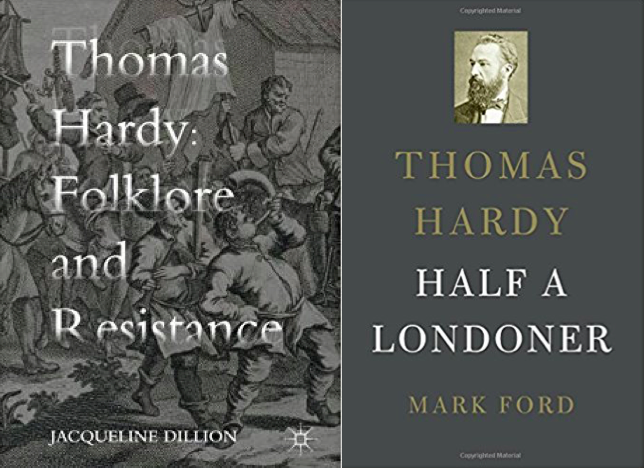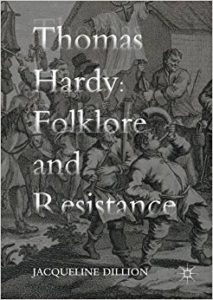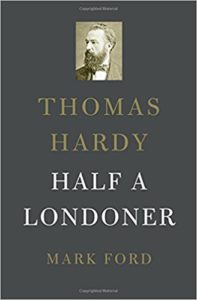


In his sociologically inflected essay on The Dorsetshire Labourer (1883), Thomas Hardy suggested that the late-nineteenth century was witnessing a general post in the English countryside, most evident on Old Lady Day in April, when the laborer’s belongings were piled onto a wagon sent by the new employer. At such times, the roads would bear witness to what Hardy perceives as an increasingly migratory tendency in rural Wessex, through which the field-laborer is losing individuality and adopting an “increasing nomadic habit,” which would inevitably lead to a “less intimate and kindly relation with the land he tills.” This diagnosis was borne out by a companion piece on the Wiltshire laborer by an authority on rural questions, Richard Jefferies, who observed that “you cannot have a fixed population unless it has a home, and the labouring population is now practically homeless,” moving around “in restlessness and discontent.” Hardy offers the gnomic contention, vis à vis the rapid changes to the rural economy, that “change is also a certain sort of education,” and this observation resonates powerfully in these two finely articulated and innovative studies of his life and work.
While Jacqueline Dillion’s focus in Thomas Hardy: Folklore and Resistance is pre-eminently and rewardingly upon the folklore elements of Hardy’s oeuvre, Mark Ford’s Thomas Hardy: Half a Londoner offers the first full-length consideration of Hardy’s tangled relations with the metropolis. Hardy’s oscillating encounters with London may be defined within three phases: the first period when, as a young man in the 1860s, he worked as an apprentice architect in Arthur Blomfield’s office near Trafalgar Square; subsequently, in the mid-1870s, Emma and Hardy set up as a newly-married couple in the south London suburbs, at the outset of his “second” career as a writer; and lastly, from the early 1890s up to the Great War, as a successful and celebrated author, he and his wife were able to spend several months each year renting apartments in order to participate in the London “Season.” The final macabre staging of this complex city/country dialectic came about when Hardy’s corpse, minus the heart, was transported to Woking crematorium prior to his ashes being placed in Westminster Abbey, while his heart was buried in the familial surroundings of Stinsford church. As Ford plangently remarks of this bizarre sequence of events, which Florence Hardy was later to deplore, “there is a great deal of difference between a symbolic heart and a real one” (Ford 8). However, it is to the author’s credit that he is wonderfully attentive to the movements of Hardy’s “aesthetic” heart in the city, both in his literary career and in his often imaginary or fantasised erotic encounters. It was the varied, challenging and sometimes destabilizing experiences of the metropolis in all its kaleidoscopic variety which, in Ford’s account, permitted Hardy “the kinds of perspective on Dorset that would enable him to transform it into Wessex”(Ford 13), and this perspective, as Ford adds, encompassed “deracination, thwarted idealism, distrust of established religion, and sexual anxiety (or indeed helplessness), a heightened sensitivity to the complexities of class privilege and to the ruthless depredations of the class system” – in other words, many of the defining symptoms of the Hardyesque “ache of modernism,” which, in the later novels, would also progressively seep into Wessex.
By contrast, Jacqueline Dillion pertinaciously demonstrates, with expertly deployed and rigorous research, the ways in which Hardy’s own life would coincide with “a shift in the effective definitions of ‘folklore’” and ‘the folk,’ to the extent that the identity of the ‘folk’ became a contested question” (Dillion 5). As Ford notes, the publisher Charles Kegan Paul published a laudatory review of Hardy’s early novels, but needled the author by patronizingly observing that he was “sprung of a race of labouring men in a county where real old families are attached to the soil.” This stung Hardy into a riposte (perhaps also prompted by the snobbish Emma?), insisting punctiliously that the Hardys had never been journeymen-laborers but rather, “master-masons, with a set of journey-men masons under them.” As Ford pithily remarks, “far from taking ‘exceeding pride’ in ‘the dignity of labor’ and his ancestral connections to a race of labouring men, Hardy was eager to make it clear that his family was a rung above journeymen” (Ford 209). But Kegan, Paul’s main point, as Ford acknowledges, was to demonstrate “that Hardy is profoundly and ancestrally in touch with English country life” (Ford 210). It is this putative familial and cultural “ancestry,” which Dillion elaborates with a fruitful wealth of evidence, and she is scrupulous in showing how, especially in the later novels (as in the contemporaneous essays of Richard Jefferies), there are “many variants on ‘folk,’ a category which then virtually disappears in the increasingly urbanized and rootless ambience of Jude the Obscure. Dillion is particularly innovative in dismantling the myth that Hardy indulged in a great degree of artistic licence in his portrayals of rustic life; to the contrary, as she demonstrates convincingly, Hardy “took pains to clarify that specific folk customs and beliefs were based on organic local tradition,” and this antiquarian methodology lay behind Hardy’s dramatic and telling exploration of such practices as “overlooking,” effigy burning, the skimmington ride, mumming, divination, and May Day and bonfire night processions , not to mention the “Portland custom” of premarital intercourse. To the entire range of folklore practices, whether genuinely immemorial or part of nineteenth-century “invented tradition,” Dillion proves a sure-footed guide.
While this seemingly buried material evidently provided Hardy with a rich source of plot, characterization, and symbolism in his novels and short stories, it is clear that, as Ford argues, London would by contrast offer him “social, sexual, and professional opportunities that would never have come his way had he remained…like William Barnes, a lifelong resident of the country of his birth” (Ford 17). The city evoked a range of “phobias and anxieties,” which formed a potent mixture of “attraction and repulsion” for the young Hardy in a pattern of psychic stimulus and disturbance, which Ford traces with tact and insight. Such anxieties and instabilities, however, are in fact far from absent in Hardy’s Wessex, as Dillion shows in her fascinating account of overlooking, magic and “hag-riding.” In The Return of the Native, for instance, Dillion remarks that Susan Nonsuch “has no qualms about stabbing Eustacia with a needle in church” so that “rainwater begins to permeate Eustacia’s body,” her effigy “melting to nothing,” and shortly afterwards “the real Eustacia drowns in the weir” (Dillion 53). Other folklorish manifestations, such as the devastating hag-riding in “The Withered Arm,”, or John South’s deathly obsession with the elm tree, testify to the dark and unsettling forces underlying the apparent serenity of Wessex. Ford similarly illuminates some troubling aspects of Hardy’s vision of London, the young architect’s account of the Lord Mayor’s pageant, for example, sees him “inspired to a nightmarish comparison of the masses filling the streets to a single, inhuman, voracious, primal monster” (Ford 19). Here and elsewhere in his writing, Hardy appears to succumb to a type of “sensory overload” stimulated by the urban crowds, which Stephen Arata has defined as constituted of “too many images, too much noise, too much information…often resulting in nervous collapse, neurosis, dysfunctions of various kinds.” In some of the evidence assembled by Ford, Hardy appears as a type of urban flaneur, experiencing a species of psychogeography as he drifts haplessly through city spaces, registering his fascinated and sometimes appalled sense of the hermeneutically elusive identity of London, that emptiness or “lack” at its heart which, as Julian Wolfreys has observed, is “always a mysterious supplement that escapes signification.” This ‘“supplement,” it may be, would trigger a quasi-Formalist “defamiliarization” in his literary registration and representation of the city. Certainly, as Ford convincingly demonstrates, the young architect’s early experience of the capital generated feelings of isolation and alienation, but this was counterbalanced by the programme of dedicated, intense, wide-ranging self-education to which Hardy submitted himself at this juncture, along with the club-like sociality of Blomfield’s office, and the somewhat shadowy erotic pursuit of Eliza Nicholls. Ford writes perceptively of Hardy’s initial London sojourn, which included the macabre task of inspecting mass exhumations required by the expanding rail network which was simultaneously opening up Wessex to outside communication and trade. Much of this urban material was to provide the substance of his unpublished first novel, The Poor Man and the Lady, to be reworked in Desperate Remedies and elsewhere, but this concatenation of psychic and literary elements would be transformed with Hardy’s visit to St Juliot, where in early 1870 he first encountered Emma Gifford.
The permeable generic boundaries between Hardy’s prose and poetry sometimes gesture towards a version of the Derridean thesis that a literary genre is dissolved at the moment of its establishment. Whilst Ford’s accounts of the rural/urban dialectic which fuels such narratives as Desperate Remedies, A Pair of Blue Eyes and The Hand of Ethelberta are soundly based and effective, it is his intuitive readings of the poetry which offer the deepest perspective into this “chasm” in Hardy’s imagination. Ford’s finely modulated interpretation of the writer’s Horace Moule poems, shadowed by his mentor’s suicide, or of such texts as “A January Night” (set in suburbia, and signalling the onset of his marital problems), or “Snow in the Suburbs,” is characterized by an almost clairvoyant understanding the poet’s psyche. This plangent emotional disturbance, however, also possesses a social aspect in the apparently more placid pastoral spaces of Wessex, as Dillion reveals in her folklore analysis, as evidenced in the public humiliation of marital infraction entailed in the practice of the skimmity ride. Dillion brings telling detail and scrupulous research to her account of the ways in which, in Dorset, “rough justice” was administered and potently refracted, not only in The Mayor of Casterbridge, but also in an early poem, “The Bride-Night Fire,” to echo as cultural memory in Tess of the d’Urbervilles and Jude the Obscure. Hardy’s unstable and shifting representation of issues of class and sexuality in the rural economy, Dillion shows, is mirrored in the “Portland custom,” a “relic” somewhat humorously explored in the two versions of The Well-Beloved (1892, 1897) which “struggles to survive in a rapidly changing world” (Dillion 118), whilst Hardy’s own involvement in the London season at this time, intriguingly investigated by Ford, was similarly marked by a balance “between the satirical and the erotic” (Ford 213). The gallery of artistic or aristocratic women with whom Hardy became infatuated bears witness to the peculiar attractions of the London season at a stage when the Hardys’ marriage was on the rocks, and Ford’s concluding discussion of Hardy’s longest London poem, “The Woman I Met,” meditates most revealingly on the striking “layering of the otherworldly and the banal” in this text (Ford 252). By contrast, Dillion’s final sections survey the more public Wessex social practices of bonfire night, mumming plays and maypole dances, but she is careful to note how Hardy “chronicles a transitional period that prefigures and suggests Freud’s arguments in Civilisation and Its Discontents” (Dillion 158). The strategic interplay between a culture of the folk and the various “invented traditions” of the period often means that Hardy’s texts are situated, as Dillion argues, in “a moral no-man’s land, in which neither folk tradition nor moral law operates effectively” (Dillion 171).
The juxtaposition of these two antithetically focused and finely-crafted Hardy studies might, in conclusion, be productively framed by some reference to the classic sociological distinction between Gemeinschaft and Gesellschaft first propounded by Ferdinand Tönnies in 1887 (the year of the publication of The Woodlanders). Gesellschaft denotates “life in the public sphere, in the outside world,” while in Gemeinschaft, Tönnies argues, “we are united from the moment of our birth with our own folk.” Community, in this analysis, “means genuine enduring life together, whereas Gesellschaft is a transient, superficial thing.” Whatever the stresses within rural society, such as those manifest in some of the folk practices studied by Dillion, in the countryside, Tönnies proposes, “there is a complete unity of human wills:” community of blood translates therefore into “community of place” in a structure of feeling with deep consequences and implications for Hardy’s writing. By contrast the city, in Tönnies’ thesis, is characterised by a sense of isolation and separation which emerges as “aggressive inner feelings and antagonistic interests,” which are to some degree, in the emergent “administered society,” “concealed by contractual relationships.” The big city, under this analysis, thus functions as “the archetype of pure Gesellschaft,” In the later nineteenth century, Tönnies maintains, ‘cities become more influential…than the rural, village organisation.” It is to the credit of the fertile and perceptively articulated work of both Mark Ford and Jacqueline Dillion that the implications and resonance of Hardy’s work emerge as more richly complex than Tönnies’ somewhat schematic definition might allow. In sum, these two original and eloquent studies succeed, even in the overcrowded field of Hardy critical scholarship, in shedding valuable new light on the problematically fertile imbrication of rural and urban in his career as man and writer.
Reviewed by Roger Ebbatson, Lancaster University
Thomas Hardy: Folklore and Resistance
by Jacqueline Dillion
Publisher: Macmillan
Hardcover / 206 pages / 2016
ISBN: 9781137503190
Thomas Hardy: Half a Londoner
by Mark Ford
Publisher: Belknap Press
Hardcover / 336 pages / 2016
ISBN: 9780674737891




